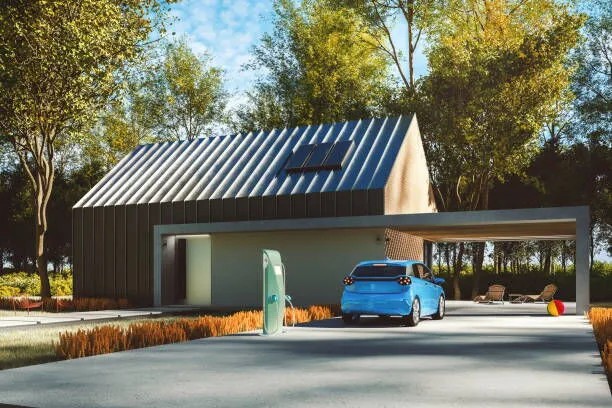As a Leading EV Charger Manufacturer in China, LiCB Charge Delivers Reliable AC and DC Electric Vehicle Charging Stations Along with Comprehensive Charging Solutions.
As electric vehicles (EVs) continue to gain popularity, many drivers ask: What’s the best way to charge my EV at home? Whether you’re a new EV owner or planning to switch, understanding your home charging options is key to maximizing convenience, efficiency, and the lifespan of your vehicle.
Home EV Charging: Your Options
There are two primary ways to charge your EV at home: Level 1 and Level 2 charging.
Level 1 Charging (120V Outlet)
- Uses a standard household 120-volt outlet — the kind you use for lamps or small appliances.
- Most EVs come with a Level 1 charging cable that plugs directly into this outlet.
- Adds roughly 3 to 5 miles of range per hour.
- Fully charging a typical EV battery can take 20 to 40 hours, depending on battery size.
- Suitable for drivers with short commutes who can charge overnight.
- No special installation needed — just plug and play.
Level 2 Charging (240V Outlet)
- Requires a dedicated 240-volt outlet, similar to those used by electric dryers or ovens.
- Requires a compatible Level 2 EV charger and professional installation.
- Adds about 20 to 30 miles of range per hour.
- Charging time typically ranges from 6 to 10 hours for a full charge.
- Faster, more practical, and future-proof for most EV owners.
- Installation may require electrical panel upgrades and professional inspection.
When Level 1 Charging Works—and When It Doesn’t
Advantages of Level 1
- Simple, accessible, and no installation costs.
- Ideal for light daily driving (under 40 miles/day).
- Perfect if you can consistently charge overnight.
- Great for renters or city dwellers without installation options.
- Works well where electricity costs are low or off-peak rates apply.
Limitations of Level 1
- Slow charging becomes an issue as battery sizes grow.
- If you drive more than the limited miles Level 1 adds overnight, you risk insufficient range.
- Prolonged use may overload home circuits not designed for continuous heavy load.
- Potential risks include tripped breakers, warm outlets, and electrical wear.
- Safety concerns if home wiring isn’t up to date.
Is Charging at 120V Harmful?
- Charging at 120V is gentle on your EV’s battery.
- However, older or poorly maintained home electrical systems may face overheating or breaker trips.
- Regular inspection of outlets and wiring is recommended if Level 1 charging is your primary method.
Why More EV Owners Choose Level 2 Charging
- Charges 5 to 8 times faster than Level 1.
- Enables convenient overnight charging, even with large batteries.
- Supports smart charging apps and energy management.
- Can increase your home’s resale value by appealing to EV buyers.
- Provides a smoother, more reliable charging experience.
The Ideal Outlet: NEMA 14-50
- The most common Level 2 outlet is the NEMA 14-50, a 240V, 50-amp receptacle.
- Similar to outlets used for electric stoves or RV hookups.
- Requires a dedicated 240V circuit and professional installation.
- Widely supported by popular home chargers like JuiceBox, ChargePoint, and Wallbox.
- Installation must consider panel capacity, grounding, and safety codes.
What Does Installation Cost?
- Level 1 Charging: Usually free, included with your EV, but slow.
- Level 2 Charger Unit: Typically $300–$800.
- Professional Installation: $500–$2,000 (varies based on panel upgrades, wiring distance, permits).
- Federal or state rebates often offset some costs.
Renting or Living in an Apartment?
- Installing Level 2 chargers may be limited.
- Options include:
- Asking your landlord to install a dedicated outlet.
- Using public Level 2 or DC fast chargers nearby.
- Using portable Level 2 chargers in shared 240V outlets.
- Many cities offer curbside chargers or incentives for multi-unit dwellings—check local programs.
Final Thoughts: Plan for the Future
Your home EV charging setup is an investment not just for today, but for years to come as EVs evolve:
- Level 1 charging can get you started but has speed and infrastructure limits.
- Level 2 chargers offer faster, safer, and more convenient charging.
- Always consult a licensed electrician to ensure safe, code-compliant installation.
- Choose a setup that balances your budget, driving needs, and home electrical system.
Key Takeaways
- Level 1: Affordable, accessible, but slow and potentially stressful to home wiring over time.
- Level 2: Faster, more efficient, ideal for most EV owners, and adds home value.
- NEMA 14-50 outlets are the standard for Level 2 charging.
- Safety and professional installation are essential for any upgrades.
- Future-proof your EV ownership with the right home charging setup.
Whether you’re just starting your EV journey or ready to upgrade, a suitable home charging solution will keep you on the road — day or night.Know more about Google SEO Directory





Comments